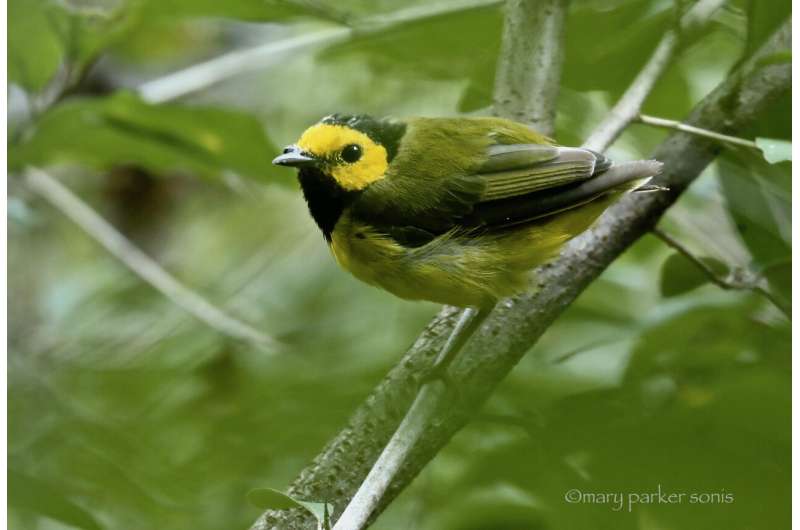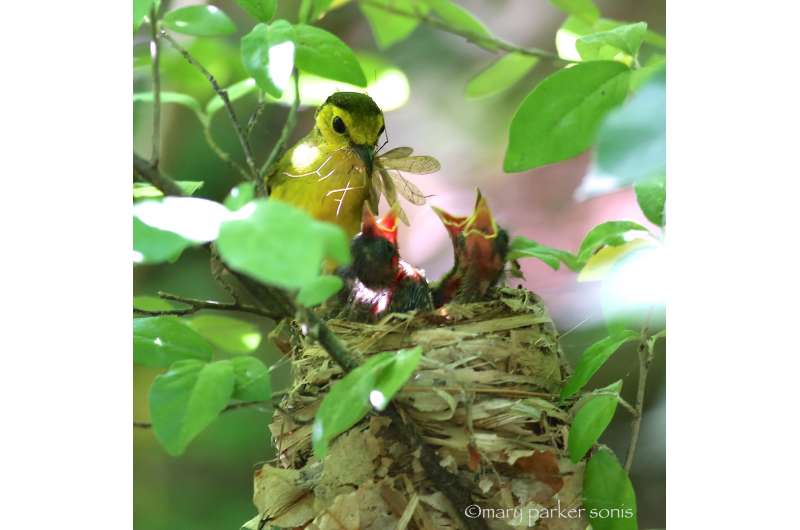A male Hooded Warbler in intense flight-feather molt. Males with this molt status, simultaneously replacing all 12 tail feathers and multiple flight feathers on each wing, have limited flight and foraging capabilities and typically desert late-season nests, making females responsible for all remaining parental care. Credit: Mary Parker Sonis
A new study of a migratory songbird shows that when fathers abandon late-season nests during flight-feather molt, the nestlings suffer no ill effects; deserted females effectively double their maternal efforts and completely compensate for the loss of male care.
The recent findings constitute "a pretty cool example of how sexual conflict over parental care can be resolved," says Will Harrod, a senior at Allegheny College in Pennsylvania and one of the study's authors. "The resolution works out great for nestlings and molting males, but maybe not so great for deserted females."
The new research, published in Ibis, the journal of the British Ornithologists' Union, focuses on the Hooded Warbler, a small songbird that spends a brief summer nesting in the forests of eastern North America. During August and early September, adults replace all the feathers in their plumage as part of the annual molt, a task that must be completed before they migrate south to their wintering grounds along the Caribbean coast of southern Mexico and Central America.
Hooded Warblers have a suite of traits that makes conflicts between parental care and molt likely, especially in males. First, their prolonged nesting season extends into August, a month that other North American songbirds typically reserve for molt. Second, their diet consists primarily of flying insects that are captured in an unusual way; the birds use their white tail spots and tail-flicking behavior to flush prey hidden in vegetation. Third, the birds employ the odd strategy of molting and replacing all their tail feathers at the same time they are also replacing multiple flight feathers on each wing. And fourth, males begin molt 2-3 weeks earlier than females, making temporal overlap between nestling care and molt particularly likely in males.
Many male Hooded Warblers consequently find themselves in the difficult position of being simultaneously engaged in both late-season nestling care and high-intensity flight feather molt. Accomplishing both tasks would require males to find enough food to feed themselves and their offspring at a time when their own nutritional requirements are high and their ability to fly and forage is significantly diminished.
Previous work had shown that males facing this dilemma nearly always desert, leaving the female responsible for all remaining parental care. But how does the female respond to male desertion, and what are the consequences for the nestlings?
A female Hooded Warbler delivers a mouthful of crane flies to three eight-day-old nestlings. When molting males desert, females effectively double their provisioning rates, and nestlings are fed, gain weight, and survive at the same rate as nestlings in biparental nests. Credit: Mary Parker Sonis
Harrod and coauthor Ron Mumme, a Professor of Biology at Allegheny College, answered these questions by examining parental care, growth, and survival of young in late-season nests at Hemlock Hill Field Station in northwestern Pennsylvania. They found that females pick up the slack left by deserting males and completely compensate for the absence of male care; nestlings from deserted nests are fed, gain weight, and survive at the same rate as young from nests where both parents are present.
The complete compensation by females makes desertion an attractive no-cost option for molting males, allowing them to focus their energies solely on feather replacement. "If desertion was in some way harmful to the nestlings," says Mumme, "males probably wouldn't be so quick to desert."
While desertion is not costly to nestlings and likely to benefit molting males, it obviously places considerable additional demands on deserted females, who must effectively double their maternal efforts when males are absent. Deserted females may feed their nestlings 20 or more times an hour. If the nest is successful, the heavy workload continues until the young become nutritionally independent about 35 days after hatching. Extended female-only care is likely to create several challenges for deserted females, including delaying their own molt and migration south to the Caribbean, and perhaps reducing their chances of surviving and returning the following year to breed again.
When male desertion is likely, however, female Hooded Warblers make it less burdensome by laying fewer eggs. Clutch size in late-season nests is usually 2-3 eggs, compared to 3-5 eggs typical of early-season nests. "Complete compensation seems to be no problem for females with two or three nestlings," says Harrod, "but it might become a problem if there were four or five mouths to feed." Another factor that may ease the burden of male desertion is that late-season nests are usually attempted only by older, experienced females that may be better prepared to deal with the likely contingency of male desertion than younger, less experienced females would be.
"You might think that male desertion would be a big disappointment to females," Harrod says, "but they seem to anticipate it and plan for it."
The researchers note that there are still many unanswered questions about Hooded Warbler nest desertion, including how male desertion affects the survival and future reproduction of females, and why males molt so much earlier than females. "Those two questions alone will keep us out in the field for several more years," says Mumme.
More information: William D. Harrod et al. Females compensate for moult‐associated male nest desertion in Hooded Warblers, Ibis (2020). DOI: 10.1111/ibi.12850
Provided by Allegheny College

























